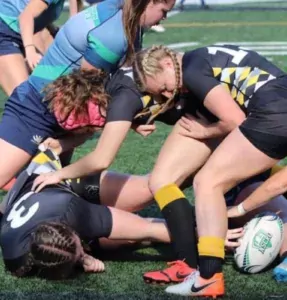Unlocking the Game-Changing Strategy
In the dynamic world of rugby, where brute force meets precision, strategy plays a pivotal role in determining victory or defeat. While scoring tries and preventing the opposition from doing the same are essential components of the game, there’s a hidden gem that can turn the tide in an instant – turnovers. This article delves deep into the art of creating and exploiting turnovers in rugby, uncovering the strategic brilliance that can make all the difference between triumph and disappointment on the pitch.
What are Turnovers in Rugby?
Before we delve into the strategy behind turnovers, it’s essential to understand what turnovers actually are in the context of rugby. In simple terms, a turnover occurs when the attacking team loses possession of the ball to the defending team, typically during open play. This shift in possession can be a game-changer, offering the defending team an opportunity to launch a counter-attack and potentially score points.
The Power of Disruption
Forcing Errors
One of the most common strategies for creating turnovers is to force errors on the part of the attacking team. This involves intense defensive pressure, with players aiming to disrupt the flow of the opposition’s attack. The art of tackling, rucking, and mauling comes into play here, as defenders seek to dispossess the ball-carrier or force a handling error.
Counter-Rucking
Counter-rucking is a specialized skill in rugby that involves competing for the ball on the ground after a tackle. When executed effectively, it can result in a turnover, as the defending team steals the ball from the attacker in the ruck. Timing and technique are crucial in counter-rucking, as players must maintain their balance while contesting possession.
Interceptions
Interceptions are perhaps the most dramatic form of turnover. It occurs when a defender reads the opposition’s pass or play and snatches the ball out of the air, often leading to an immediate counter-attack. This skill requires anticipation, quick reflexes, and the ability to read the game, making it a prized asset for any defensive player.
The Art of Exploiting Turnovers
Creating turnovers is only half the battle. To maximize their impact, teams must have a well-thought-out strategy for exploiting these opportunities. Here’s a closer look at the tactics involved:
Quick Transition
One of the most critical aspects of exploiting turnovers is the speed of transition from defense to attack. As soon as possession changes hands, the defending team must shift their mindset and execute a swift transition. This involves getting the ball into the hands of the backs and utilizing the element of surprise before the opposition can organize their defense.
Support Play
Support play is vital when exploiting turnovers. Players must be in the right positions to receive offloads or passes from the player who secured the turnover. Effective support play ensures that the attacking team can maintain momentum and exploit the gaps in the opposition’s defense.
Communication
Clear and precise communication is paramount during turnover situations. Players need to convey their intentions quickly to ensure everyone is on the same page. This communication extends to calling plays, signaling for passes, and coordinating movements to capitalize on the turnover effectively.
Identifying Weaknesses
Exploiting turnovers also involves identifying and targeting the weaknesses in the opposition’s defense. This requires a high level of rugby IQ, as players must assess the situation quickly and make strategic decisions about where to attack. Whether it’s exploiting an overloaded side, isolating a defender, or finding space in the backline, recognizing and exploiting vulnerabilities is key.
The Role of Leadership
Leadership on the field is instrumental in both creating and exploiting turnovers. Captains and experienced players often play a central role in driving the team’s defensive strategy. They are responsible for instilling discipline, maintaining composure, and making crucial decisions in high-pressure situations, such as when a turnover occurs.
Turnovers as Momentum Shifters
Turnovers can be potent momentum shifters in a rugby match. When a team creates a turnover, it not only disrupts the opponent’s attack but also injects a surge of energy and motivation into the defending side. This change in momentum can have a ripple effect, inspiring the team to play with greater intensity and determination.
Psychological Impact
The psychological impact of turnovers should not be underestimated. For the attacking team, losing possession can be demoralizing, leading to frustration and self-doubt. Conversely, the defending team gains confidence and belief in their ability to thwart the opposition. This shift in mindset can significantly impact the flow of the game.
The Role of Game Situation
The strategy behind creating and exploiting turnovers can vary depending on the game situation. In some cases, a team may prioritize securing possession and kicking for territory to relieve pressure. In others, the focus may be on launching an immediate counter-attack to catch the opposition off guard.
Late in the Game
Late in a closely contested match, the strategy around turnovers becomes even more critical. Teams that are trailing may adopt a more aggressive approach, risking turnovers in pursuit of a game-changing play. Conversely, teams with a lead may prioritize ball retention and territorial control to run down the clock.
Field Position
Field position also influences the strategy surrounding turnovers. When a turnover occurs deep in the attacking team’s territory, the defending side may opt for a conservative approach, such as kicking for touch to gain territory. On the other hand, turnovers closer to the opposition’s try line may prompt a more aggressive attacking strategy.
Training and Preparation
The ability to create and exploit turnovers doesn’t happen by chance. It’s the result of rigorous training, meticulous preparation, and a deep understanding of the game. Here are some key aspects of training for turnovers:
Defensive Drills
Defensive drills are essential in preparing players to create turnovers. These drills simulate game situations and focus on skills like tackling, rucking, and counter-rucking. Players learn to work as a cohesive unit to disrupt the opposition’s attack.
Decision-Making
Rugby is a fast-paced sport, and split-second decisions can determine the outcome of a turnover situation. Training often includes decision-making drills that challenge players to read the game, anticipate the opposition’s moves, and make the right choices under pressure.
Scenarios and Game Simulation
Simulating game scenarios is crucial for replicating the intensity and unpredictability of turnovers. Coaches use controlled scrimmages and game simulations to test their team’s ability to create and exploit turnovers in a realistic setting.
Video Analysis
Video analysis has become an invaluable tool for rugby teams. Coaches and players review game footage to identify areas for improvement, study the opposition’s tendencies, and fine-tune their turnover strategies.
The X-Factor
While strategy, training, and preparation are vital, there’s also an intangible element at play when it comes to turnovers—the X-factor. This term refers to the unpredictable and extraordinary moments that can occur in a rugby match. These moments often involve individual brilliance, where a player pulls off a remarkable turnover or exploits one with sheer talent and athleticism.
Individual Brilliance
The X-factor can manifest in the form of individual brilliance, such as a player executing a breathtaking tackle, winning a crucial turnover, or launching an audacious counter-attack. These moments can electrify the crowd and elevate a player to legendary status.
Game Changers
Players with the X-factor are often referred to as “game-changers” because they have the ability to single-handedly alter the course of a match. Their presence on the field can strike fear into the hearts of the opposition and inspire their teammates to new heights.
Conclusion
In rugby, turnovers are not merely transitions of possession; they are opportunities waiting to be seized. The strategy behind creating and exploiting turnovers is a complex and multifaceted aspect of the game, where a combination of skill, preparation, and game understanding comes into play. Whether it’s through forcing errors, quick transitions, or the magic of the X-factor, turnovers can turn the tables in an instant, transforming a defensive struggle into an attacking triumph. Mastering this art can be the key to victory, making turnovers a fascinating and crucial element of the sport.

